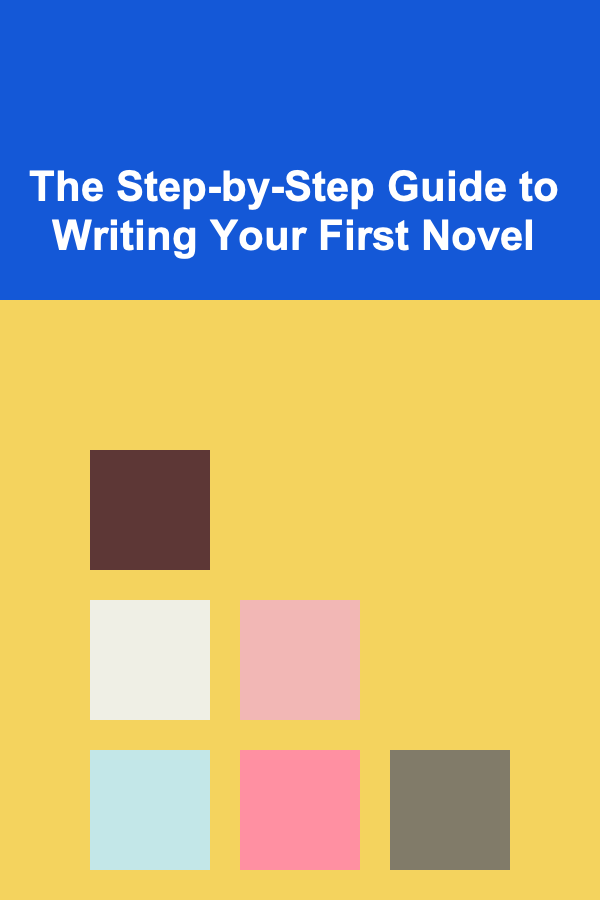
The Step-by-Step Guide to Writing Your First Novel
ebook include PDF & Audio bundle (Micro Guide)
$12.99$7.99
Limited Time Offer! Order within the next:

Writing your first novel is an exciting, challenging, and often daunting endeavor. It requires creativity, discipline, and perseverance. Whether you have been dreaming of becoming a novelist for years or you've only just decided to embark on this journey, this step-by-step guide will help you turn your idea into a finished manuscript.
In this guide, we'll break down the process into manageable steps, covering everything from planning to writing to editing and eventually publishing your novel. By the end of this article, you'll have a comprehensive understanding of how to approach novel writing and the confidence to take your first step as an author.
Preparing to Write: The Foundation of Your Novel
Before you dive into the actual writing process, it's important to lay a strong foundation for your novel. This phase involves brainstorming, outlining, and developing the characters, setting, and plot.
1.1. Finding Your Inspiration
The first step in writing any novel is finding inspiration. Inspiration can come from a variety of sources---life experiences, books you've read, movies you've seen, or even dreams. Sometimes, it may be a single idea or moment that sparks the desire to write.
Ask yourself:
- What story do I want to tell?
- What emotions or themes am I passionate about exploring?
- Do I have a particular setting or character in mind?
Don't be afraid to draw from personal experiences or your own imagination. Every writer has their own unique process for finding inspiration, so take your time and let your ideas evolve naturally.
1.2. Developing the Core Concept
Once you've found your inspiration, it's time to hone in on the core concept of your novel. This is the foundation of your story---the idea that will drive the plot forward.
Ask yourself:
- What is the main conflict of the story?
- Who are the key characters, and what do they want?
- What is the world like in which the story takes place?
For example, if you're writing a fantasy novel, the core concept might be about a young hero discovering their hidden powers. If it's a mystery, your core concept could be a detective investigating a series of crimes.
1.3. Creating the Characters
Characters are the heart and soul of your novel. Without well-developed characters, your story can feel flat and unengaging. Take the time to create characters with depth and complexity.
Start by defining:
- Protagonist: Who is the main character, and what do they want? What motivates them, and what are their flaws?
- Antagonist: Who or what opposes the protagonist? This could be a villain, a force of nature, or even the protagonist's own internal struggles.
- Supporting characters: Who else plays a role in the story? These could include friends, family members, mentors, or rivals.
Think about their backstories, personalities, and how they will evolve throughout the novel. The more detailed your character development, the more real and engaging your characters will feel.
1.4. Deciding on the Genre
The genre of your novel will determine many aspects of the story, including tone, pacing, and structure. Some common genres include:
- Fantasy: Often set in imaginary worlds with magic and mythical creatures.
- Science fiction: Typically set in the future or in space, exploring advanced technology and the impact of science.
- Romance: Focuses on the relationships between characters and often involves themes of love and personal growth.
- Mystery/Thriller: Centers around solving a crime or uncovering secrets.
- Historical fiction: Set in the past, with a focus on historical events and characters.
Choose a genre that resonates with you and fits the story you want to tell. You can always mix genres, but it's important to understand the conventions of the genre you're working within.
Plotting Your Novel: Structuring the Story
Once you have the core concept, characters, and genre in mind, it's time to plan the plot. Some writers prefer to outline every detail, while others prefer a more organic approach. Regardless of the method, a strong structure is essential to keep the story moving forward.
2.1. Plotting Techniques
There are several methods you can use to structure your novel. Here are a few of the most popular ones:
- The Three-Act Structure: This is a classic structure used in many stories. It divides the plot into three parts: the setup (Act 1), the confrontation (Act 2), and the resolution (Act 3).
- The Hero's Journey: This is a narrative structure often used in fantasy and adventure stories. It follows a hero who embarks on an adventure, faces a crisis, and ultimately returns transformed.
- The Snowflake Method: This method starts with a simple sentence describing the story and gradually expands it into a detailed outline, adding complexity step by step.
- Pantser vs. Plotter: Some writers prefer to write by the seat of their pants (pantsers), allowing the story to unfold as they write. Others prefer to plot everything out beforehand (plotters).
You can use a combination of these methods or create your own approach. The key is to develop a structure that keeps you motivated and allows the story to flow naturally.
2.2. Building the Plot
Start by developing the major events that will occur throughout the novel. These events should be tied to the protagonist's goals, conflicts, and growth.
- Inciting Incident: The event that sets the story in motion and forces the protagonist to take action.
- Rising Action: The series of events that build tension and lead to the climax.
- Climax: The turning point of the story, where the protagonist faces their greatest challenge.
- Falling Action: The events that occur after the climax, leading toward the resolution.
- Resolution: The conclusion of the story, where the conflict is resolved and the character's journey is complete.
Each scene should serve a purpose and move the plot forward, whether by revealing new information, developing characters, or advancing the conflict.
2.3. Worldbuilding (for Fantasy and Science Fiction)
If you're writing in a genre like fantasy or science fiction, worldbuilding is an essential part of the process. You'll need to create a detailed and believable world where your story takes place. Consider the following elements:
- Setting: What does the world look like? Is it a real place, or is it imaginary?
- Rules: What are the rules of the world? Is there magic? What technology exists? How do people interact with the world around them?
- Culture: What kind of societies exist? What are the customs, traditions, and values of the people in this world?
The more detailed your worldbuilding, the more immersive your story will feel.
Writing Your Novel: The Creative Process
Now that you've planned your story, it's time to start writing. This is often the most challenging phase of the process, but it's also the most rewarding. Here are some tips to help you stay on track.
3.1. Set Writing Goals
Writing a novel can feel overwhelming, but breaking it down into smaller, manageable goals can help you stay motivated. Set daily or weekly word count goals and track your progress. Even if you only write a few hundred words a day, it will add up over time.
3.2. Create a Writing Routine
Consistency is key to completing your novel. Set aside a specific time each day to write, whether it's in the morning, during lunch, or in the evening. Find a quiet space where you can focus and minimize distractions.
3.3. Embrace the First Draft
Don't worry about making your first draft perfect. The goal is to get your ideas down on paper and build momentum. You can always revise later, but for now, focus on getting the words written.
3.4. Overcome Writer's Block
Writer's block is a common challenge for many writers. If you find yourself stuck, try the following techniques:
- Take a break and do something else for a while.
- Write without thinking, even if it's just gibberish.
- Skip ahead to a scene that excites you and come back to the tough part later.
- Talk to a fellow writer or friend about your story to generate new ideas.
Editing and Revising: Polishing Your Manuscript
Once you've completed your first draft, the next step is editing and revising. This is where your novel truly begins to take shape.
4.1. Take a Break
After finishing your draft, set it aside for a few days or even weeks. This break will give you a fresh perspective when you return to it and make it easier to spot issues with pacing, character development, or plot consistency.
4.2. Self-Editing
When you start editing, focus on the big picture first. Look for issues with the plot, characters, and pacing. Ask yourself:
- Does the story flow logically?
- Are the characters well-developed and consistent?
- Is the dialogue natural and engaging?
After addressing the big-picture issues, focus on the details---grammar, spelling, punctuation, and sentence structure.
4.3. Get Feedback
Once you've revised your manuscript, it's time to get feedback. Share your novel with trusted friends, beta readers, or a writing group. Choose readers who are familiar with the genre and who will give you honest, constructive feedback.
4.4. Final Polishing
After receiving feedback, make any necessary revisions and give your manuscript one last polish. This is the stage where you'll fine-tune the details and ensure that everything is as tight and compelling as possible.
Publishing Your Novel
Once your novel is complete and polished, it's time to consider publishing options. You have two main choices: traditional publishing or self-publishing.
5.1. Traditional Publishing
Traditional publishing involves submitting your manuscript to literary agents or publishers. If your manuscript is accepted, you'll work with professionals to edit, design, and publish your book. However, the process can be competitive, and rejections are common.
5.2. Self-Publishing
Self-publishing allows you to publish your novel independently. There are several platforms, like Amazon Kindle Direct Publishing (KDP), where you can upload and sell your book. Self-publishing gives you more control over the process but also requires you to handle marketing, design, and distribution yourself.
Conclusion
Writing a novel is a long and rewarding process. It requires planning, hard work, and dedication, but the result is something that can be deeply fulfilling. Whether you pursue traditional publishing or choose to self-publish, writing your first novel is an achievement in itself.
By following the steps outlined in this guide, you'll be well on your way to completing your first manuscript. So, take a deep breath, start writing, and enjoy the journey of bringing your story to life.

Copywriter's Guide to Conversions: Turning Words into Sales
Read More
How to Inspect and Maintain Your Home's Water Filtration System
Read More
How to Organize Supplies and Tools in Your Garage Inventory
Read More
How to Use Pendant Lights to Enhance Your Home Decor
Read More
How To Live in a Small Apartment with Minimalist Style
Read More
Sketching Buildings and Cityscapes: A Comprehensive Guide
Read MoreOther Products

Copywriter's Guide to Conversions: Turning Words into Sales
Read More
How to Inspect and Maintain Your Home's Water Filtration System
Read More
How to Organize Supplies and Tools in Your Garage Inventory
Read More
How to Use Pendant Lights to Enhance Your Home Decor
Read More
How To Live in a Small Apartment with Minimalist Style
Read More